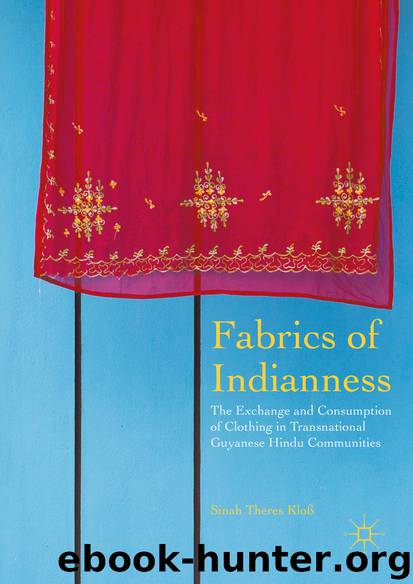Fabrics of Indianness by Sinah Theres Kloß

Author:Sinah Theres Kloß
Language: eng
Format: epub
Publisher: Palgrave Macmillan US, New York
Creating the Garment
The ‘Invention’ of Vestment
The revitalization since the 1960s is of particular relevance for the study of contemporary sartorial practices. The standardization of ritual clothing and the development of a specific dress code were intricate parts of the consolidation process of the tradition, as specific vestment emphasized the unity of the religious community in a hostile environment. Furthermore, the vestment signified continuity with ‘ancient’ Indian traditions, hence legitimized the religious tradition. This is particularly owed to the color ‘dye’ (yellow, turmeric), which symbolizes not only Mudda but also India. ‘Dye’ underlines the Indianness of Madrassis, and hereby creates a specific Madrassi standard according to which ‘respectability’ is evaluated.
Church clothing or clothes described as ‘Sunday best’ have always been a category of clothing that is considered to be of higher value than everyday clothing. Priests and ritual practitioners wear specific clothes that denote them as authorities, set them apart from lay devotees, purify them, and may even imbue them with the spiritual power to conduct puja. In colonial Guyanese society, as addressed in Chap. 3, clothes were among the most important means to represent status and the ability to rule or lead people. Specific dress codes represent discipline and organization (Buckridge 2004, 96). Similarly, the implementation of a standardized dress code in the Madras tradition serves as a means to display and actively construct organizational and religious sophistication. This process is not exclusive to the Madras tradition, but is also relevant for other Hindu traditions in Guyana.
Ritual clothing or the clothing of priests, the clergy, and ritual practitioners are defined as vestment in the following. A vestment is a garment or piece of clothing that is worn by an authoritative person such as a king or priest, usually on a ceremonial occasion or during service. Clerical vestment is an important aspect for the construction, representation, and maintenance of a liturgical standard. Just as specific activities such as the preparation of food and offerings may be considered liturgical, so is the use of specific paraphernalia and other objects required during religious service, including robes. Vestment is part of the established dress code and therefore a means to establish and display cultural complexity, restrictions, and discipline. Although vestment symbolizes tradition and stability, it underlies changes, adaptations, and even fashions. With regard to Madrassi vestment, traditional ‘Indian’ clothing was adapted and standardized: for men, this usually is a white or light yellow dhoti, a waistband (red or ‘Madras’ cloth), and a white or, less common, light yellow T-shirt; for women, this is a yellow shalwar or gharara with a red or Madras waistband, called ‘Madraskerchief’ (see Fig. 4.1). Particular characteristics are common in all temples, but minor variations can be noticed among the discussed ‘ways,’ as has been discussed with regard to the length of dhotis earlier. Furthermore, I witnessed the application of scarfs as markers of high status during a Big Puja of a temple identified as Tamil.
Fig. 4.1Manifestation in front of Sangani’s temple. The female practitioner (center) is dressed in a dye shalwar tied with a Madraskerchief and is soaked from cooling dye water.
Download
This site does not store any files on its server. We only index and link to content provided by other sites. Please contact the content providers to delete copyright contents if any and email us, we'll remove relevant links or contents immediately.
| Anthropology | Archaeology |
| Philosophy | Politics & Government |
| Social Sciences | Sociology |
| Women's Studies |
Born to Run: by Christopher McDougall(7028)
The Leavers by Lisa Ko(6878)
iGen by Jean M. Twenge(5326)
Sapiens by Yuval Noah Harari(5264)
The Kite Runner by Khaled Hosseini(5038)
Spare by Prince Harry The Duke of Sussex(4997)
Bullshit Jobs by David Graeber(3995)
Machine Learning at Scale with H2O by Gregory Keys | David Whiting(3973)
Never by Ken Follett(3706)
Goodbye Paradise(3666)
Livewired by David Eagleman(3624)
Fairy Tale by Stephen King(3157)
Harry Potter 4 - Harry Potter and The Goblet of Fire by J.K.Rowling(2942)
A Dictionary of Sociology by Unknown(2926)
The Social Psychology of Inequality by Unknown(2901)
The Club by A.L. Brooks(2812)
Will by Will Smith(2738)
0041152001443424520 .pdf by Unknown(2728)
People of the Earth: An Introduction to World Prehistory by Dr. Brian Fagan & Nadia Durrani(2673)
